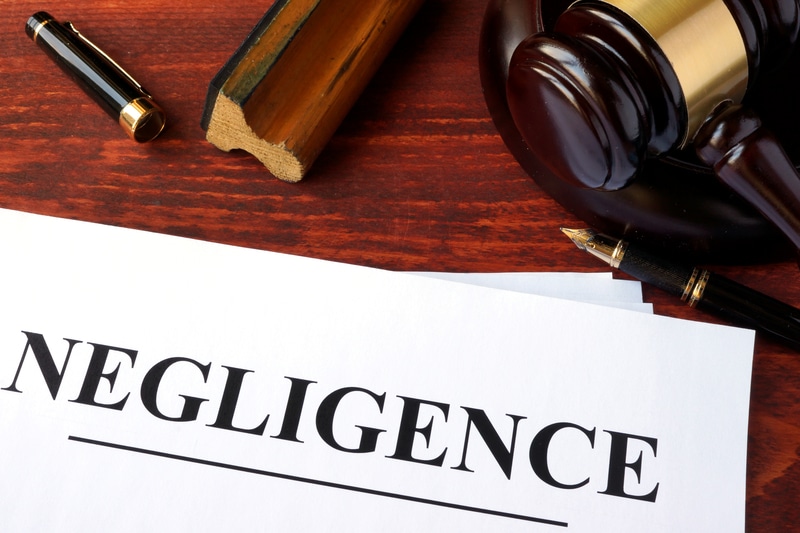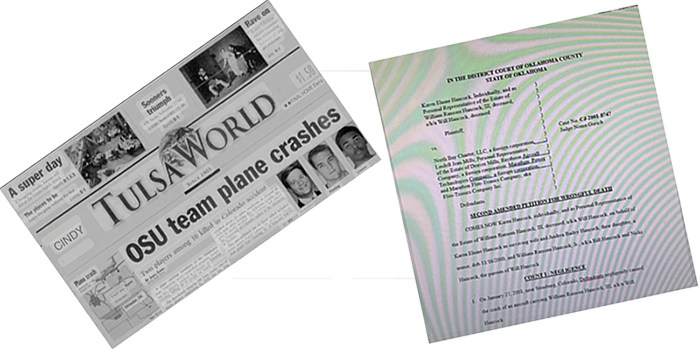How Negligence Impacts a Lawsuit

Have you recently been injured due to someone else’s carelessness? If so, you may wonder if you have a valid personal injury case. Making an accurate determination is a complicated process. The first thing your personal injury attorney will need to establish is whether or not the other party was negligent. This article is an overview and will look at what negligence is and how it can impact your case. What is Negligence? For someone to be held liable for your injuries, their actions must have fallen below the standards of care that a reasonable person would have met in the same situation. This is known as negligence. For example, if you are walking across the street and a driver runs a red light and hits you, their actions would likely be considered personal injury negligence. On the other hand, if you were walking down the street and slipped on a patch of ice that had not been shoveled or salted, the property owner might not be found negligent because there was no way for them to know that the ice was there. For negligence to occur, four main elements must be present: duty, breach of duty, causation, and damages. Duty The first element is duty. The plaintiff (the person filing the lawsuit) must prove that the defendant (the person being sued) owed them a duty of care. This means the defendant was obliged to act a certain way to avoid harming the plaintiff. For example, all drivers must operate their vehicles safely to avoid injuring other motorists. Breach The second element is breach. The plaintiff must show that the defendant breached their duty of care by failing to act as a reasonable person would have under similar circumstances. Returning to our earlier example, if a driver ran a red light and collided with another vehicle, they would be considered to have breached their duty of care by failing to act as a reasonable driver would have under those circumstances. Causation The third element is causation. The plaintiff must prove that the defendant’s breach of duty was the cause of their injuries. This means that the plaintiff would not have been injured by the defendant’s actions. Damages The fourth and final element is damages. The plaintiff must show that they suffered some type of loss or harm as a result of the defendant’s negligence. This could be physical injuries, emotional distress, property damage, or financial losses such as lost wages or medical bills. If any of these elements is missing, there can be no negligence. For example, if the defendant did not owe the plaintiff a duty of care (say, for example, if you were hit by a car while trespassing on private property), then they cannot be held liable for your injuries-regardless of how unreasonable their actions may have been. How Does Negligence Impact Your Personal Injury Case? As mentioned above, negligence is necessary for liability in a personal injury case. If your attorney can establish that the other party was negligent, they will likely be held responsible for any damages you suffered due to their actions. These damages can include economic and non-economic losses such as medical bills, lost wages, pain and suffering, and more. However, even if negligence can be established, some protections are still in place for defendants in personal injury cases. For example, many states have laws limiting how much money plaintiffs can recover for pain and suffering damages. Additionally, suppose the plaintiff was partially at fault for their own injuries (say, they were jaywalking when they were hit by a car). In that case, they may have their damage award reduced by an amount proportional to their level of fault under what is known as comparative negligence laws. In some states, if the plaintiff is more than 50% at fault, they may be barred from receiving any damages at all. Conclusion If you’ve been injured due to someone else’s careless behavior, you may wonder whether you have a valid personal injury case. The first step in answering this question is to establish whether or not negligence occurred-and this blog post has hopefully given you a better understanding of what negligence is and how it can impact your case. Of course, this is just a general overview; for specific advice tailored to your unique situation, contact one of our highly qualified Attorneys at 580-224-0900 for a free consultation.
Oklahoma City Wrongful Death Lawyer

Find An Oklahoma City Wrongful Death Lawyer Right Away Do you need to find an Oklahoma City wrongful death lawyer but don’t know where to start? This guide will help you find the right person for the job. That way, you can get the outcome you are looking for this case to bring with it. You’re going to want to work with someone that has done wrongful death casework before. You want to know that they are going to be able to get you the compensation your family deserves for the death of the loved one you’re going to court for. You don’t want a general lawyer that may be able to help that doesn’t really specialize in this kind of thing because they may miss things and cause the outcome to not be in your favor. You want someone that is trained in wrongful death cases and knows exactly what and/or who to go after. Before you work with a lawyer, you should determine if they have handled this type of case in the past. You want to know what other people thought of their services and if they would hire them again if they had a case like this to deal with in the future. If all you find are negative reviews, then it’s best to avoid the lawyer even if they charge a rate that’s a lot cheaper than the rest. The reason they may be so cheap is that they can’t get clients any other way due to them having a bad reputation. You need to let your lawyer know exactly what happened and what you know about the case. Don’t talk to anyone like a company that calls to ask you question about the death. Always refer people to your lawyer or tell them you have to ask your lawyer about whether or not you can answer. There are people out there that will try to trick you into saying something you shouldn’t say that can hinder your chances of winning your case. So, only be open with your lawyer and tell them when you have people hounding you for more information. A good Oklahoma City wrongful death lawyer shouldn’t be too hard to find. You just have to do your research on who is out there that is good at what they do. Take your time with it and in the end, you’ll be happy with who you pick. For more information contact one of our highly qualified Attorneys at 580-224-0900 for a free consultation.
How Negligence Impacts Lawsuits

Unfortunately, most people are unaware of the fact that it is now possible to file a lawsuit and seek compensation for injuries resulting from someone else’s negligence. The amount of physical, emotional, and financial strain resulting from such negligence warrants a legal claim, and individuals/corporations alike should be held accountable for their actions. What is Negligence? Whether you’re dealing cases of improper medical practice, a car accident, or your run of the mill case of “slip and fall,” negligence is the term used to hold a party liable for events leading up to your injury. This legal theory requires some burden of proof in many cases and claims involving injury. Effective legal representation is crucial in these cases, for the main reason that proving negligence is a complex process that requires some level of expertise. In principle, any careless act that results in injury to another is considered negligent behavior. It is crucial to keep in mind that whether you choose to settle the case out of court, or if you have enough proof to go to trial, the evidence of this legal principle needs to be airtight. How to Prove Negligence If you do decide to go through with your lawsuit, then there are four critical elements you need to satisfy to prove, beyond a reasonable doubt, that the defendant is liable and expressly responsible for negligent behavior. These four factors include duty, breach, causation, and damages. Let’s look at them in a bit more detail, shall we? Elements of a Negligence Claim Legal Duty This is usually the easiest to prove, especially where corporations are concerned. The concept of legal duty indicates that you should be accorded some level of care, as a bare minimum, by the person liable of negligence. An example of statutory responsibility is an injury you sustain at the workplace due to poor working conditions. The legal duty is a prevalent factor when it comes to proving cases dealing with medical malpractice suits, where doctors abuse a patient’s right to efficient medical care. Duty can also be proven if the injury you sustain is a result of an accident, where the accused flouts traffic rules and causes harm. There are several other examples, but the crux of it is, if you have some professional relationship with the accused, then they are bound by the element of legal duty. Duty Breach After establishing legal duty, you will need to prove, in totality, that there was, in fact, a breach. This is achieved through a practice that shows how an ordinary, responsible party (a reasonably prudent person) would have responded under the same circumstances. This legal standard sets a statute to how the defendant ought to have responded in that situation. It also proves why this response constitutes negligence. Essentially, the idea behind establishing a breach of contract is to prove that the defendant’s actions directly resulted in injury. Causation The next element on how to prove negligence involves a process that determines actual bodily harm. Proving negligence is one thing, but for you to get any form of compensation, then you must prove, conclusively, that this lack of forethought caused the injury in question. There has to be a direct link between your injury and the defendant’s negligent behavior. Most plaintiffs are known to try and increase compensation by tying unrelated incidents into the lawsuit, which is both ill practice and dishonest. Note that you can be prosecuted for lying under oath, so ensure any injury you suffer truly reflects negligent behavior and isn’t an attempt to defraud someone else. There is also the consideration of “unforeseeable” circumstances. This occurs when proof indicates that the defendant couldn’t have anticipated the injury caused, and hence couldn’t have acted any differently. Random acts of nature and other variables may tilt the scale in the defendant’s favor. Damages The last element of how to prove negligence plays on the court’s ability to render compensation to you, as the plaintiff for the injury resulting from the defendant’s negligence. This is done after satisfying that, indeed the injury was a result of negligence. For the most part, this compensation is monetary, and it takes into account resultant property damage or medical expenses that you may have incurred. Bottom Line Trying to pursue a personal injury case can be difficult without the right kind of professional assistance, especially if you’re going up against a corporation. You need to find a litigator who is both experienced and has the industry expertise to get you the compensation you deserve! For more information contact one of our highly qualified Attorneys at 580-224-0900 for a free consultation.


